The Application of Wu Xing Philosophy to Wu Xing Painting
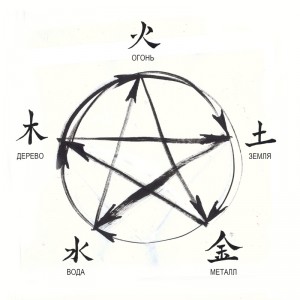 In an article “A word about Wu Xing Painting” we have already talked about how the five Wu Xing elements relate to the five movements of Wu Xing painting. I’ve tried to give a detailed explanation about the principles of Wu Xing system and their application in this style of painting so that we are quite clear on this point.
In an article “A word about Wu Xing Painting” we have already talked about how the five Wu Xing elements relate to the five movements of Wu Xing painting. I’ve tried to give a detailed explanation about the principles of Wu Xing system and their application in this style of painting so that we are quite clear on this point.
When classifying brushstrokes, movements, and composition according to Wu Xing, we should follow our inner guidance and avoid hard judgments shaped by our “thinking heads”. We should always bear in mind that Wu Xing is a five-dimensional integrity where any object invariably has five characteristics. We can try and draw an analogy between these objects and those of our three-dimensional space. In our three-dimensional world each object has three basic parameters (along the three axes of x, y and z): width, depth, and height. No object in nature is devoid of height, it’s just that some objects are higher than others. The five-dimensional Wu Xing is much the same. No movement can be clearly defined as “wood” or “fire” movement. All five components are initially present in any one movement, it’s just that some of them are more pronounced, while others are less obvious.
How the Wu Xing concept manifests in this style of painting is a frequently asked question. In this article we’ll try to answer it as thoroughly as possible.
First of all, we should differentiate between the three important concepts:
1) The form of an image
2) The form of a brushstroke
3) The type of movement
The key to Wu Xing painting method is the movement. If we look up the hieroglyph 五行 (Wu Xing) in a dictionary, we’ll see that its first meaning is ‘movement’. What’s really important for the Wu Xing painter is to capture the unique quality of energy and state of being of any given image or phenomenon using a certain type of brushstroke. For example, a bird is a fast-moving creature and so in most cases it’s better to paint it in fleeting brushstrokes. But first the artist has to match the form of a brushstroke and the form of an image. This is a moment that brings new discoveries as there is a certain connection between the form and energy of a natural object and the energy of the artist who paints it.
As we begin to explore the Wu Xing movements, the first thing to note is that they can be yin or yang. In Wu Xing painting yin movements correspond with softness, gentleness, refinement, gradual change and unhurried action, while yang manifests through speed, swiftness, sharpness, directness and pushiness. As we know from an article about the Wu Xing system, its five elements are borne from yin-yang interaction. The implementation of this principle is most obvious in Wu Xing painting and its movements. In this popular video I demonstrate the five brushstrokes of Wu Xing painting in a compelling visual way.
The Wood element is yang. Wood in movement manifests through directness and swiftness. Outwardly it resembles a fast and powerful blow. The wood movement in its essence conveys the sensation of growing, sprouting, bursting. A successful growth needs rhythm. That’s why a clear and brisk rhythm is an integral feature of this type of movement. When using wood movement, the painter hammers in the nails, so to speak.
The form of a brushstroke created by the wood movement can vary, although most often it is a line that starts and ends with a dot, much like the basic lines of Chinese calligraphy − a horizontal line, a vertical line, and various obliques and curves. Traditionally, this type of brushstroke is used to paint bamboo. But it is just as good for painting various trees and mammals. Sometimes the wood movement can even render the energy of a mountain or a rock.
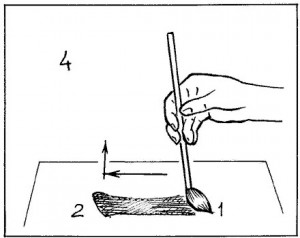
(all brushstroke patterns come from www.chinart.ru)
The Fire element is the climax of yang. A powerful fire movement can look like an explosion, whereas a gentle fire movement can be like a light breath of wind or a flap of a butterfly’s wing. Fire is quick, fleeting, and elusive. Fire in movement is an ability to quickly shift from one emotional state to another.
A fire brushstroke often looks like a boat or a drop. It is well-suited for painting fishes, birds, leaves, and flower petals − all that is fleeting and transient.
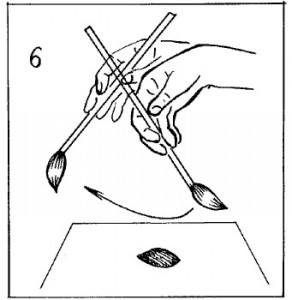
Earth provides structure. The earth movement is calm and measured. Earth in movement is the art of applying various kinds of pressure and the right kind of weight.
The earth brushstroke is a simple dot, a spot, a brush applied to paper one time only. This element is best suited for painting rocks, turtles, and various arthropods. Just as pressure is a basic attribute of movement, a dot is a basis of any brushstroke. Earth is the central Wu Xing element, with yin and yang expressed in equal measure.
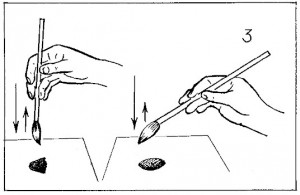
Metal in movement is the opposite of wood qualities. Wood is directness, sharpness, pressure, weight, a dash forward, whereas metal is flexibility, refinement, and gradual progress. Both wood and metal have their own rhythms, but that of metal is much smoother. It manifests in gradual lightening of pressure into finer brushstrokes. Metal brushstrokes resemble the movements of a snake.
The metal movement results in an elongated brushstroke. It starts with a dot and ends in a sharp point, like the point of a needle, or the tip of a swishing whip, or the blade of a long sword. This brushstroke is used for painting grass, wild orchid leaves, and various snakes. The metal brushstroke is also a great asset when it comes to depicting river rocks and smooth lake water.
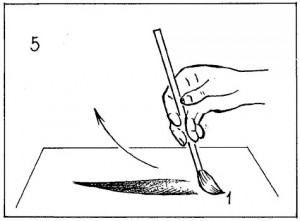
Water in movement is incorporeal, just like the fire movement. Where the metal movement acts as a June antipode to wood, the water movement stands in opposition to the fire movement. Fire is fleeting and elusive, whereas water is infinitely swirling and twisting. It is the longest of all movements. The water movement resembles a vortex that draws one’s attention deep inside.
The water brushstroke is like a burning incense trail. It is best suited for painting twisted trunks of bonsai trees, rose and peony flowers, weeds and water-plants, limbs, shells and bodies of mollusks, and a wood in the background with all its details blurred together.
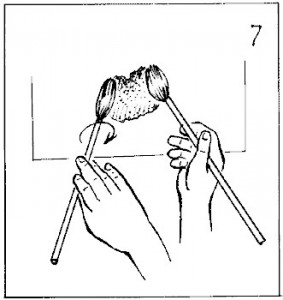
Each Wu Xing movement corresponds to a specific area of the body. Since our arm is all we’ve got to paint with, we should know which part of it we use. The strongest movements arise at the root of our arm, i.e. in the shoulder. That’s where the powerful wood movement resides. The “malleable” metal movement results from slow raising of the elbow. The fleeting fire springs up from the wrist. The delicate swirling of water needs extreme finesse and sensitivity and so it lives in the fingers. The earth movement engages the whole arm.
There is also another, more substantial model of movements, in which the basic wood and earth movements arise in the lower part of a belly together with the chest rotations. If the arms are drawn up into the shoulders, the elbows hang low, and the chest “falls” into the rounded waist, then the movement passes through the arms and goes right into the “painting” wrist. This posture is very similar to a standard “horse stance” posture in all types of quigong and wushu. Painting in this posture is best done in the full-lotus or half-lotus position.
There is also a standing posture that is suitable for painting. Here the legs help create movements that become imprinted on a sheet of paper as brushstrokes. This style of Wu Xing painting is akin to dance or martial arts such as tai chi chuan, ba gua zhang, or xinyiquan.
As a painter perfects the art of Wu Xing painting, he follows the same path as a calligrapher in the classical tradition of Chinese calligraphy. First, one has to master the basic elements. A calligrapher practices the basic strokes, while a painter perfects the basic brushstrokes. Then a calligrapher starts combining separate elements to form hieroglyphs that are written in the regular style of kaishu. At the same time, a painter starts assembling simple images using single brushstrokes. Next, a calligrapher makes a transition to a cursive style of hieroglyphs when he can write a hieroglyph with a single stroke. Wu Xing painting follows the same pattern. At some point one has to progress to fast painting, i.e. painting various subjects with a single stroke and to discover the Wu Xing system once again through this integral movement.
For many people, Wu Xing painting can be an excellent tool of self-development, a method of honing specific life skills. If your movements are constrained and your body is stiff because of various psychophysical blocks, you can’t express the fleeting nature of a butterfly, the subtle beauty of a bent-over blade of grass, or the straightforward sincerity of a bamboo tree. To apply such a brushstroke, you will have to change. Thus Wu Xing painting can be seen as a method of body-oriented psychotherapy.
Now let’s talk about the integrity of a painting. Both a calligrapher and a Wu Xing artist eventually progress from honing single strokes and brushstrokes to an integral composition. One of the frequently asked questions is whether a Wu Xing painting should include all the five types of brushstroke. The answer is not as obvious as it might seem. This is because the integrity of Wu Xing movements belongs to the level of movements rather than shapes or brushstrokes. The Wu Xing harmony expresses itself not in a specific painting but in an overall behavior of this or that person: in the way he moves and talks, and the kind of life he lives. Of course, a harmonious painting rests on the Wu Xing integrity, but those movements are of a different kind. Here we are not concerned with movements of the painter’s arm but with how the viewer’s eye moves through the painting. The Wu Xing theme can be revealed in both the composition and the movement through the basic concepts of yin and yang.
Yang is a starting point of the viewer’s journey through the painting, while yin is its final destination − the receiver of the eye movement, a point where it comes to an end. In the simplest case, yang denotes the place with the highest density of images, while yin denotes empty space. Many Chinese paintings are woven of emptiness that swallows the viewer’s eye. But of course “the diffusion perspective” is not the only way to direct the point of attention.
Wood denotes a way of directing the viewer’s eye through a painting using a sequence of interacting images. In such a painting, the gaze travels from one image to another in the same way that a brush moves from dot to dot when you paint a bamboo tree. Such movement always leads to a specific subject. So we are free to say that a tree in a painting generates its subject. This subject has to excite the viewer and to grab his attention. If one wants to make the painting quite dynamic or to set it up as an adventure, then the wood composition is a perfect choice. In some people such paintings instigate excitement or even aggression.
In this type of composition yang acts as a starting point in a sequence of images that direct the viewer’s eye, whereas yin completes this sequence of interconnected images. For example, in a painting “Magpies and Hare” by a famous Chinese artist Cui Bai of Song dynasty (see a link below) the hare is yang, and the last in a row of magpies in the right upper corner is yin.
The wood element is fully expressed in monochrome paintings or in monochrome works with one extra color. The abundance of colors can distract one’s attention from the main subject of the painting.
These are paintings with a dominant wood element – To see paintings by Cui Bai of Song dynasty, go to Wikipedia:
, .
You can also see some of my paintings:
Fire in a painting corresponds with its color scheme that often determines the power of emotional response in the viewer. Colors can be warm or cool. Yang color is extremely warm. It generates warm feelings and joy. Yin color is cool. It gives rise to yin emotions: sadness, melancholy, and fear. The strongest contrast is achieved by opposing the shades of red (the fire color) and blue (the water color). This technique was widely used in making Japanese woodblock prints ukiyo-e.
See
You can also see my paintings:
Earth is related to structure. In fact, earth is the very structure of a painting. Structure is determined by a ratio of its constituent parts. For example, let’s analyze the structure of our day. If it’s a working day, the biggest part of it is taken up with work that overshadows all other activities. The structure of a painting can be assessed by the ratio of its images, or rather by the ratio of its color patches. Yang is the biggest patch of color, and yin is the smallest. All the phenomena of linear perspective that propels us into the distance, towards the horizon, can also be referred to the Earth element. Or it can be the other way round, like in Chinese landscape painting shan shui that often uses a reverse linear perspective.
These are just a few examples of this type of composition in the paintings by Chinese masters.
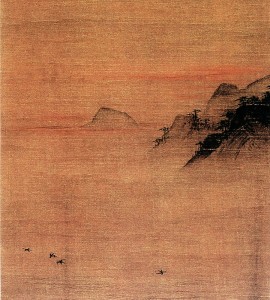
Metal in the composition is connected with the tonal contrast. Metal is something that divides. A stronger and more pure tone breaks the weaker tone into parts. If we apply black color to a white sheet of paper, the blackest color will be extreme yang, while grey shades will direct us to the extreme “white yin” space. It’s as if we travel down the tonal steps from the darkest color to the lightest. Metal provides the painting with depth as well as foreground and background. Pure colors and extreme contrast feature only in the foreground where metal is strong yang. The further away, the less contrast there is – metal weakens in the background and becomes more yin. Metal is easier to render in a monochrome painting, same as wood.
Metal stands in opposition to wood and has the opposite effect. Wood excites, while metal brings calm. “Metal” paintings usually evoke a sense of peace. In some people they can evoke sadness.
A painting by Chinese artist Wang Zi Xiu is a good example of a “metal” painting.
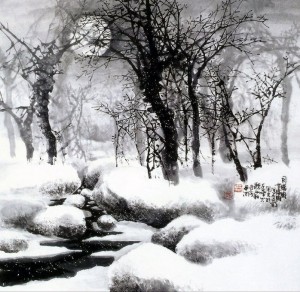
You can also see my paintings:


Paintings by Olga Kinyova are based on the same principle:
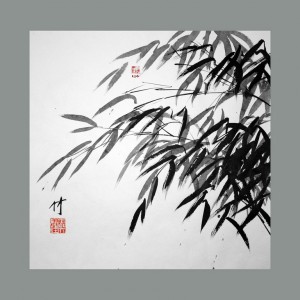
Water. The water element conveys the effect of ‘atmospheric perspective and diffusion perspective”. This technique is widely used in landscape painting. The foreground is rich in details and fine elements, while in the background the images are blurred and look like blotches and patches of color almost indistinguishable from each other. Paintings that employ this technique often evoke a sensation of diving into some hypnotic depth, which is the opposite of fire that causes outbursts of emotions. In some people “water” paintings stir up fear.
In the following paintings the compositional water technique is used to great effect. Paintings by a contemporary Chinese-Japanese artist Wang Noon are also a good example of the “water” style.
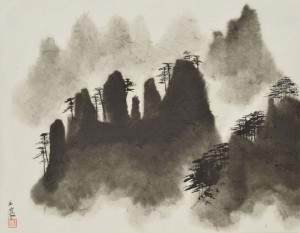
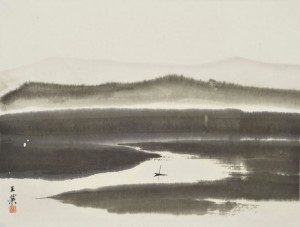
Finally, it’s worth noting that in traditional Chinese painting the artist decorates his work with a calligraphic inscription and a signature stamp. These are not just technical details but have their own part to play and serve as independent compositional elements as well as “stopping points” in the viewer’s visual journey through the painting.
I’d like to say it once again that in the Wu Xing system all images are five-dimensional. That’s why one can’t envisage a painting that would employ only one compositional technique. All five of them are found in any single painting. It’s just that one technique can be expressed more fully than the others.
For this reason, there can be no obvious answer to the question of how the Wu Xing system relates to its expressive form in painting because they exist on at least two levels: Wu Xing as a brushstroke and Wu Xing as composition. But there is also a third level, i.e. picturesqueness. In a painting medium one can’t digress from it too far. And here we once again knock on the door of grandfather Young who had described the archetypal images and their meanings with much precision and in great detail. It should not be too difficult to see their connection to Wu Xing since specific images evoke specific emotions. And those of you who have read the article “The Wu Xing System of Five Energies” already know how emotions correspond with these basic elements of Chinese philosophy. Yang emotions excite and invigorate us, while yin emotions decrease our vitality.
So that’s what happens when we take it all apart. There is a wealth of information here for an artist, yet an innocent viewer usually makes a verdict on this or that painting within just a few seconds using the time-old method of “I like it/I don’t like it”. In which case other important factors come into play. I described them in an article about the four types of art criticism.
As we know, the Wu Xing system includes not only the five elements, but also the connections between them. These connections can be either nourishing or overwhelming. How do they affect the painting process? Well, this is the subject of another article. But if we try to put it in just a few words, here is a simple rule of thumb: if you want to create a painting with a yang impact, you should use fire and wood movements, and the similarly energetic images and composition. If you wish to make a yin impression, apply the same principle. This approach is also valid when you intend to make a painting with Wu Xing-related qualities. Overwhelming energies kick in when there is a clash between the type of composition and the type of a brushstroke. “The compositional element” will always overwhelm “the brushstroke element”. For example, let’s look at the classical bamboo paintings done in monochrome. Although a brushstroke used in such painting is yang and vigorous, the yin composition and the neutral mood of the image overwhelm it because “metal” overwhelms “wood”. Thus the bamboo impact we get is quite calm.
The “gong-bi” painting style that focuses on birds and flowers has quite the opposite effect. Dynamic images of birds and flowers together with the rich and vivid colors overwhelm the somewhat yin impression yielded by abundance of minute details, just as fire overwhelms metal and wood overwhelms earth.
So now you see that a rather simple question about the application of Wu Xing philosophy to Wu Xing painting requires a detailed and complex answer.















2threats